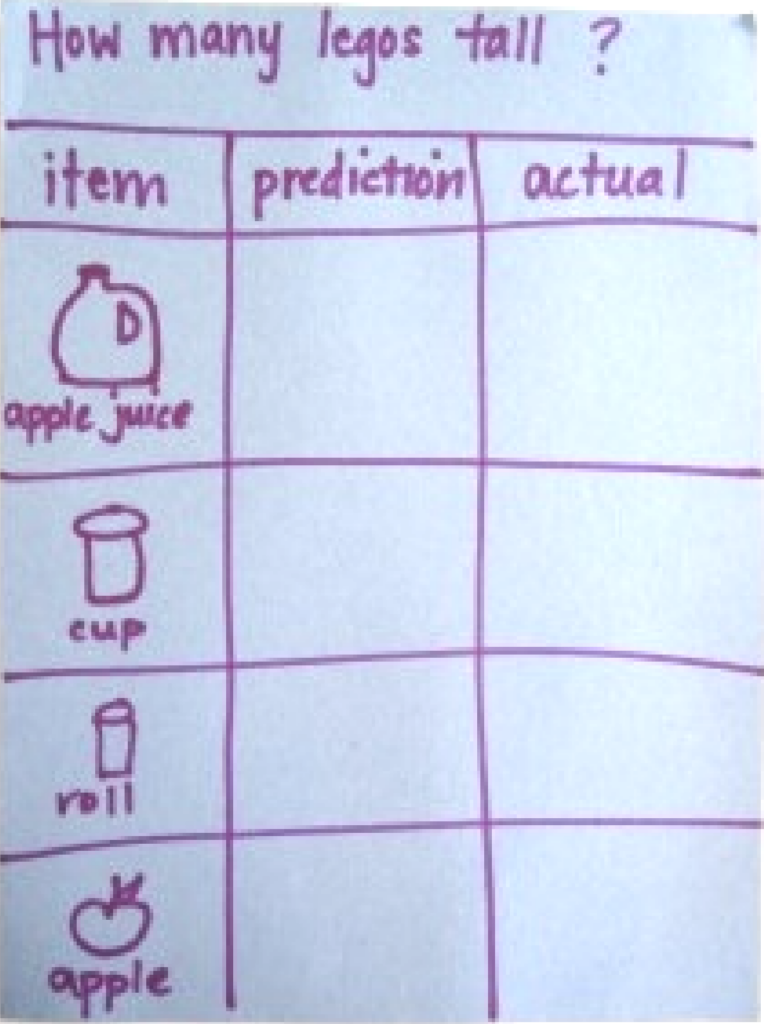Measuring With LEGO Bricks
In this lesson, the children will make predictions and use LEGO bricks to measure objects in their environment.
Learning Goals:
This lesson will help children meet the following educational standards:
- Develop beginning skills in the use of science and engineering practices such as observing, asking questions, solving problems, and drawing conclusions
- Explore the physical properties of objects
- Use tools and technology to assist with science and engineering investigations
Learning Targets:
After this lesson, children should be more proficient at:
- Collecting, describing, comparing, and recording information from observations and investigations
- Identifying, describing and comparing the physical properties of objects
- Using nonstandard and standard scientific tools for investigation
Step 1: Gather materials.
- LEGO bricks (either LEGO Duplos or regular LEGO bricks)
- Markers (to write down the measurements on the chart)
- Sheet of paper (Make a chart with three columns: a column for the items to be measured, a column for predictions, and a column for actual measurements. Draw the items for children who cannot yet read independently, but also include the item name with the drawing. See the charts below for ideas. Anything you have on hand that can be measured will do, but consider choosing items of different heights.)
The Measuring with LEGO Bricks chart shown below was downloaded from https://frugalfun4boys.com/lego-first-grade-math-pack/. Check out this website for some great math and engineering activities!


Step 2: Introduce activity.
- Ask the children: "Have you ever played with LEGO bricks? “What did you do with the LEGO bricks?”
- Explain that today the children are going to use LEGO bricks to measure items around the room.
- Pass out the lists of items to measure to the children.
- Model how the children are going to go about measuring the items on their lists. Begin with an item that is not on their list, such as a stool. Ask the children to predict how many LEGO bricks high they think the stool is. Write their predictions under that column. Using the LEGO bricks and a volunteer, measure how many LEGO bricks tall the stool is by stacking the LEGO bricks one on top of the other. Write the answer under the actual measurements column.
- Ask the children what they noticed about how many LEGO bricks tall they thought the chair would be and how many LEGO bricks tall the chair was. Was it more or fewer LEGO bricks tall than they had predicted?
Step 3: Engage children in lesson activities.
- Explain that the children are now going to measure the items on their lists. But, before they start measuring, the children will need to guess/predict how many LEGO bricks tall they think each item will be. Predict first, then measure.
- It is handy to have clipboards on hand for this activity, as it makes it easier for the children to write down their results.
- Once the children are done measuring, gather them together to discuss and record their results. The predictions will vary, but the actual measurements should be fairly consistent. If the actual answers are wildly different, then measure the items again as a group.
- Discuss the difference between a prediction, a guess and a measurement.
Step 4: Engineering vocabulary
- Conclude: To make statements about what was learned after an observation or an experiment
- Data: Information that is collected through a study or an investigation
- Measure: Use of standard units to find out size or quantity in regard to length, breadth, height, area, mass, weight, volume, capacity, temperature, and time
- Predict: To guess what might happen next
Suggested Books
- Friends Beyond Measure by Lalena Fisher
- How Big is a Foot? by Rolf Myller
- How Tall, How Short, How Far Away? by David A. Adler
- Length by Henry Arthur Pluckrose
- Me and the Measure of Things by Joan Sweeney
Comment on this lesson.